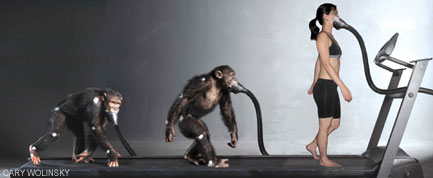
Humans walking on two legs consume only a quarter of the energy that chimpanzees use while “knuckle-walking” on all fours, according to a new study.
The finding, detailed in the July 17 issue of the journal for the Proceedings of the National Academy of Sciences, supports the idea that early humans became bipedal as a way to reduce energy costs associated with moving about.
“Walking upright on two legs is a defining feature that makes us human,” said study leader Herman Pontzer, an anthropologist at Washington University in St. Louis. “It distinguishes our entire lineage from all other apes.”
According to this theory, the energy saved by walking upright gave our ancient ancestors an evolutionary advantage over other apes by reducing the costs of foraging for food.
The idea is just one of many scientists have entertained as reasons for why humans walk on two legs. Recent studies have also suggested that, rather than taking millions of years to evolve from a hunched position as is commonly believed, our early ancestors were already capable of standing and walking upright the moment they descended from the trees.
Chimps on a treadmill
The researchers trained five chimps to walk both upright and on all fours on a treadmill. The animals wore masks and energy consumption was measured as a function of how much oxygen was consumed during the exercise. The chimp results were compared to four humans walking upright on the treadmills.
Sign up for the Live Science daily newsletter now
Get the world’s most fascinating discoveries delivered straight to your inbox.
Results showed that for a given weight, humans used only one-quarter of the energy as the chimps. On average, the chimps used the same amount of energy walking on two legs as they did on four. However, one chimp, with a longer stride, was more efficient walking upright.
The team was able to attribute performance differences between the chimps to differences in the length of their stride and the amount of muscle they activated with each step. They measured the latter by having the chimps walk across a metallic force plate.
“It’s basically an expensive bathroom scale,” Pontzer explained. “It measures how much force is being applied by the limb to the ground.”
Biomechanical equations predict that energy consumption increases either with shorter steps or more active muscle mass. The chimp that used less energy walking bipedally did so because it had longer than average legs. We humans are able to reduce both factors because of our relatively long legs and modified pelvic structures.
Reconstructing our ancestor’s gait
The team has also applied their findings to early hominin fossils. “What [our] results allow us to do was to look at the fossil record and see whether fossil hominins show adaptations that would have reduced bipedal energy expenditures,” said study team member David Raichlen of the University of Arizona. “We and many others have found these adaptations [such as slight increases in hind limb extension or length] in early hominins, which tells us that energetics played a pretty large role in the evolution of bipedalism.”
The new findings are in line with the traditional theory of the origins of bipedalism, which states that our ancestors climbed down from the forest canopy some 7 million years ago and began a long transition from walking on all fours to walking upright. However, recent studies have begun to challenge this idea.
One team recently found that wild orangutans often stand upright to balance on thin branches. Another found that the muscles gibbons use for climbing and swinging through the forest canopy are also useful for running on two legs, and thus our arboreal ancestors might have been better prepared for walking upright than previously thought.
“This would be a different view,” Pontzer told LiveScience. “We don’t need to think about [bipedalism] happening from the tree down. It seems to be very plausible that it would have happened from the ground up.”
- Top 10 Missing Links
- Did Upright Walking Start in Trees?
- Walk This Way: The Amazing Complexity of Getting Around









